What Caused Camp Lejeune Water Contamination?
- Last Updated: July 14th, 2025

Attorney Jessica Paluch-Hoerman, founder of TruLaw, has over 28 years of experience as a personal injury and mass tort attorney, and previously worked as an international tax attorney at Deloitte. Jessie collaborates with attorneys nationwide — enabling her to share reliable, up-to-date legal information with our readers.
Legally Reviewed
This article has been written and reviewed for legal accuracy and clarity by the team of writers and legal experts at TruLaw and is as accurate as possible. This content should not be taken as legal advice from an attorney. If you would like to learn more about our owner and experienced injury lawyer, Jessie Paluch, you can do so here.
Fact-Checked
TruLaw does everything possible to make sure the information in this article is up to date and accurate. If you need specific legal advice about your case, contact us by using the chat on the bottom of this page. This article should not be taken as advice from an attorney.
What Caused Camp Lejeune Water Contamination? Let's Discuss.
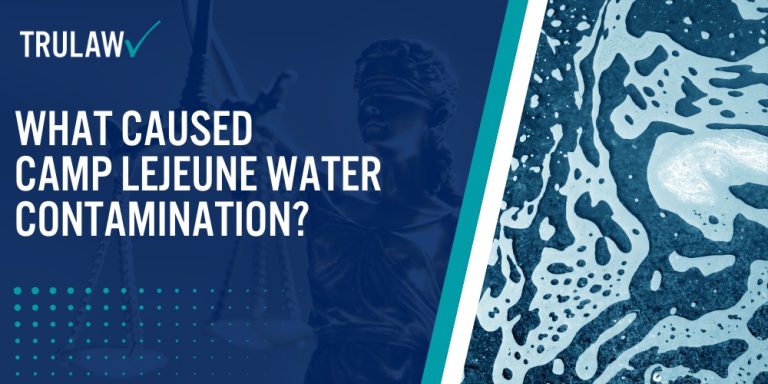
Question: What caused Camp Lejeune water contamination?
Answer: The water contamination at Camp Lejeune primarily occurred due to a chemical contamination at two (2) water treatment plants — Tarawa Terrace and Hadnot Point.
From 1953 to 1987, the drinking water at Camp Lejeune, a major Marine Corps base in Jacksonville, North Carolina, was contaminated with dangerous chemicals that have the potential to cause certain types of cancer and other serious health conditions.
Table of Contents
What Chemicals Were Contaminating the Water Supply at Camp Lejeune?
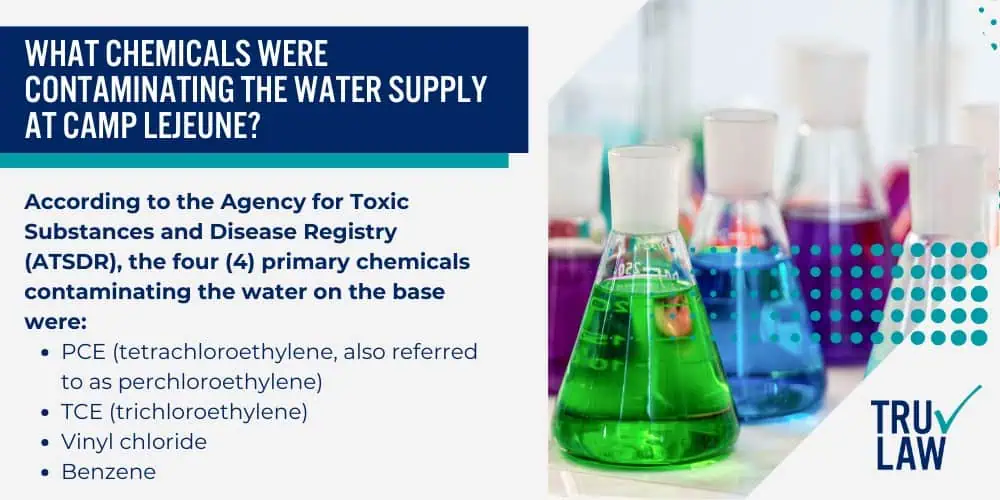
According to the Agency for Toxic Substances and Disease Registry (ATSDR), the four (4) primary chemicals contaminating the water on the base were:
- PCE (tetrachloroethylene, also referred to as perchloroethylene)
- TCE (trichloroethylene)
- Vinyl chloride; and
- Benzene.
All four (4) of the chemicals are colorless and invisible to the naked eye.
PCE is commonly used as a dry-cleaning agent, though as the ATSDR notes, it has been used for metal degreasing as well.
PCE can either rapidly evaporate from shallow soil, or it can slowly degrade in the soil over time and eventually contaminate groundwater.
TCE is a solvent and is frequently used for cleaning metal parts.
Like PCE, it is a volatile organic compound (VOC) that has a sweet odor and is nonflammable.
Over time, TCE and PCE can break down in soil and form vinyl chloride, which can pollute groundwater.
Vinyl chloride is colorless and can dissolve in water.
In industrial settings, it has numerous uses, including making PVC pipes and manufacturing certain plastic products.
Benzene has been used for a wide variety of purposes, including manufacturing resins, rubber lubricants, synthetic fibers, plastics, dyes, sunscreen, pesticides, and drugs.
Like the other chemicals, it is colorless, has a sweet aroma, and can dissolve in water.
The water contamination at Camp Lejeune primarily occurred at two water treatment plants:
- Tarawa Terrace; and
- Hadnot Point.
The Tarawa Terrace Water Treatment Facility
When tested in the early 1980s, wells at the Tarawa Terrace water treatment plant were found to be contaminated with PCE.
The source of contamination at the Tarawa Terrace facility was discovered to be a nearby, off-base dry-cleaning company known as ABC One-Hour Cleaners that failed to properly dispose of their hazardous waste.
The PCE levels at the Tarawa Terrace water treatment facility were found to significantly exceed the maximum limits for drinking water established by the Environmental Protection Agency (EPA).
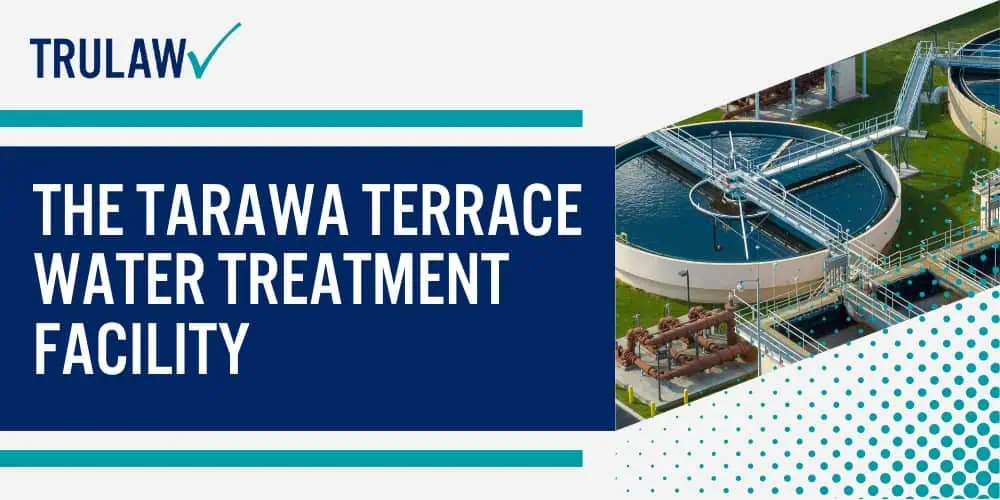
Benzene was also discovered at the Tarawa Terrace facility in the mid-1980s, though it was detected at lower levels than the maximum amount allowed.
The most contaminated wells at the Tarawa Terrace water treatment plant were retired in February 1985.
The Hadnot Point Water Treatment Facility
TCE was the primary chemical compound discovered at the Hadnot Point water treatment plant.
The maximum amount of TCE permitted in drinking water is currently .5 μg/L (micrograms per liter).
The levels of TCE detected at the Hadnot Point treatment plant reached as high as 1,400 μg/L.
Other chemicals were also discovered in wells at the Hadnot Point facility.
They included DCE (dichloroethylene), PCE, vinyl chloride, and benzene.
The wells with the most significant levels of contamination were shut down at the same time as the wells at the Tarawa Terrace water treatment facility in February 1985.
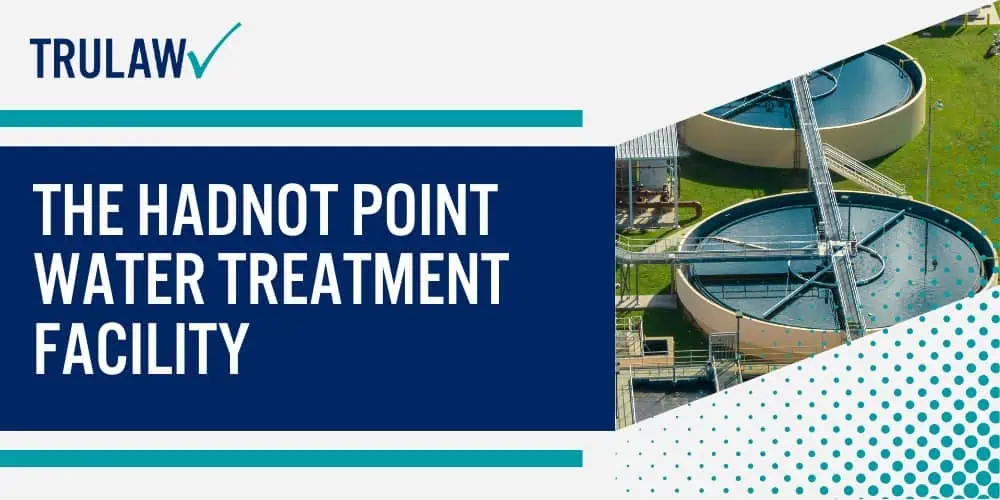
There were multiple sources of possible contamination at the Hadnot Point treatment plant.
The sources included industrial spills, leaks from underground fuel storage tanks, and waste disposal sites.
Health Issues Caused by Water Contamination at Camp Lejeune
Numerous severe side effects have been recorded in veterans and others who were exposed to contaminated water at Camp Lejeune.
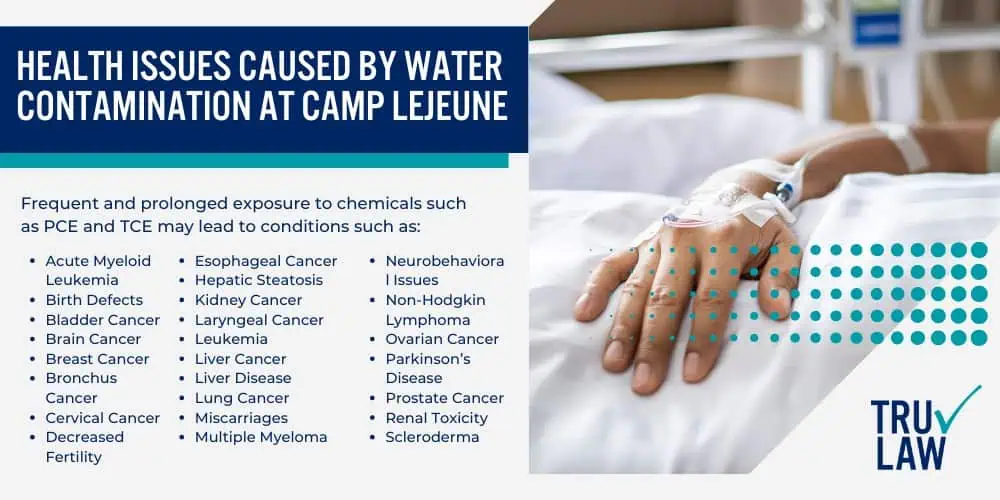
Frequent and prolonged exposure to chemicals such as PCE and TCE may lead to conditions such as:
- Acute Myeloid Leukemia
- Birth Defects
- Bladder Cancer
- Brain Cancer
- Breast Cancer
- Bronchus Cancer
- Cervical Cancer
- Decreased Fertility
- Esophageal Cancer
- Hepatic Steatosis
- Kidney Cancer
- Laryngeal Cancer
- Leukemia
- Liver Cancer
- Liver Disease
- Lung Cancer
- Miscarriages
- Multiple Myeloma
- Neurobehavioral Issues
- Non-Hodgkin Lymphoma
- Ovarian Cancer
- Parkinson’s Disease
- Prostate Cancer
- Renal Toxicity
- Scleroderma
Individuals who were diagnosed with cancer or another severe health condition after serving, living, or working at Camp Lejeune for a period of at least 30 days may be entitled to pursue compensation for damages they suffered through a Camp Lejeune Water Contamination claim.
Camp Lejeune Lawsuits
Hundreds of thousands of veterans, family members, and civilian employees at Camp Lejeune were regularly exposed to contaminated water from 1953 to 1987.
While veterans and family members with covered conditions have been able to seek healthcare benefits through Veterans Affairs thanks to 2012’s Janey Ensminger Act, they were previously time-barred from pursuing a lawsuit against the at-fault parties.
The Camp Lejeune Justice Act of 2022, which was signed into law by Congress in 2022, helped remove the legal barrier preventing victims from previously taking legal action — North Carolina currently has a 10-year statute of repose on lawsuits against polluters.

Unlike the statute of limitations, the statute of repose starts when the defendant first engages in negligent activity.
The statute of repose passed decades ago before anyone knew that the water was contaminated.
This new bill allows anyone who lived at Camp Lejeune for at least (30) days between August 1, 1953, and December 31, 1987, to file a lawsuit if they suffered certain severe health problems because of the contaminated water.
If you were exposed to contaminated water at Camp Lejeune during the specified time frame, find out how TruLaw can help.
Visit our Camp Lejeune Contaminated Water Lawsuit page and get an instant case assessment.

Managing Attorney & Owner
With over 25 years of legal experience, Jessica Paluch-Hoerman is an Illinois lawyer, a CPA, and a mother of three. She spent the first decade of her career working as an international tax attorney at Deloitte.
In 2009, Jessie co-founded her own law firm with her husband – which has scaled to over 30 employees since its conception.
In 2016, Jessie founded TruLaw, which allows her to collaborate with attorneys and legal experts across the United States on a daily basis. This hypervaluable network of experts is what enables her to share the most reliable, accurate, and up-to-date legal information with our readers!
Additional Camp Lejeune Water Contamination Lawsuit resources on our website:
Here, at TruLaw, we’re committed to helping victims get the justice they deserve.
Alongside our partner law firms, we have successfully collected over $3 Billion in verdicts and settlements on behalf of injured individuals.
Would you like our help?
At TruLaw, we fiercely combat corporations that endanger individuals’ well-being. If you’ve suffered injuries and believe these well-funded entities should be held accountable, we’re here for you.
With TruLaw, you gain access to successful and seasoned lawyers who maximize your chances of success. Our lawyers invest in you—they do not receive a dime until your lawsuit reaches a successful resolution!
AFFF Lawsuit claims are being filed against manufacturers of aqueous film-forming foam (AFFF), commonly used in firefighting.
Claims allege that companies such as 3M, DuPont, and Tyco Fire Products failed to adequately warn users about the potential dangers of AFFF exposure — including increased risks of various cancers and diseases.
Depo Provera Lawsuit claims are being filed by individuals who allege they developed meningioma (a type of brain tumor) after receiving Depo-Provera birth control injections.
A 2024 study found that women using Depo-Provera for at least 1 year are five times more likely to develop meningioma brain tumors compared to those not using the drug.
Suboxone Tooth Decay Lawsuit claims are being filed against Indivior, the manufacturer of Suboxone, a medication used to treat opioid addiction.
Claims allege that Indivior failed to adequately warn users about the potential dangers of severe tooth decay and dental injuries associated with Suboxone’s sublingual film version.
Social Media Harm Lawsuits are being filed against social media companies for allegedly causing mental health issues in children and teens.
Claims allege that companies like Meta, Google, ByteDance, and Snap designed addictive platforms that led to anxiety, depression, and other mental health issues without adequately warning users or parents.
Transvaginal Mesh Lawsuits are being filed against manufacturers of transvaginal mesh products used to treat pelvic organ prolapse (POP) and stress urinary incontinence (SUI).
Claims allege that companies like Ethicon, C.R. Bard, and Boston Scientific failed to adequately warn about potential dangers — including erosion, pain, and infection.
Bair Hugger Warming Blanket Lawsuits involve claims against 3M — alleging their surgical warming blankets caused severe infections and complications (particularly in hip and knee replacement surgeries).
Plaintiffs claim 3M failed to warn about potential risks — despite knowing about increased risk of deep joint infections since 2011.
Baby Formula NEC Lawsuit claims are being filed against manufacturers of cow’s milk-based baby formula products.
Claims allege that companies like Abbott Laboratories (Similac) and Mead Johnson & Company (Enfamil) failed to warn about the increased risk of necrotizing enterocolitis (NEC) in premature infants.
Here, at TruLaw, we’re committed to helping victims get the justice they deserve.
Alongside our partner law firms, we have successfully collected over $3 Billion in verdicts and settlements on behalf of injured individuals.
Would you like our help?
